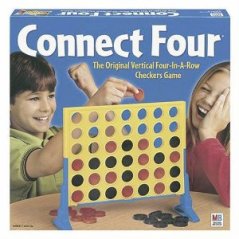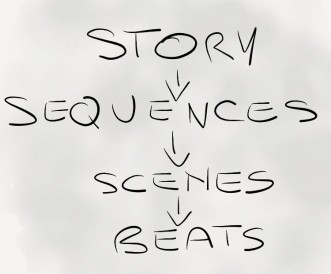 Do you know the game Connect Four? The players take turns to insert coloured discs in a vertical board aiming to have four of the same colour in any direction.
Do you know the game Connect Four? The players take turns to insert coloured discs in a vertical board aiming to have four of the same colour in any direction.
We were shooting a 3 minutes scene with two characters in a pub, talking, drinking beers and playing a game of Connect Four.
Any Script Supervisor’s nightmare scenario!
I approached the two actors to lock in continuity. I suggested keeping their business to a few moves to make it easier for them. But young Toby ran the scene with his acting partner and blocked about 20 moves. I wrote it all down on the side of my script, muttered a glum ‘good luck’ and went away to sulk by the monitors.
We turned over. First take: more or less as they blocked it. The director suggested a few changes in their performance. Second take: the new directions taken on board, but their actions the same. The two were subtly prompting each other in the game to maintain continuity. The director loved that so it all became part of the scene. Third take: a few performance changes but the actions were the same. The coverage was a breeze! Toby confirmed his moves with me before turning over and then he did it all the same.
What a relief… what a surprise! Some actors like to get extra busy in a scene but few can duplicate their actions. And there’s not enough time to shoot extra takes for continuity on TV shows. If the performance is good we move on, I pray the scene will be cut mainly in closeup and hope the audience won’t notice the changes in action.
“So Toby, how the hell did you remember it all?” His answer was ‘the key’ that changed the way I worked.
But I need to digress. There’s a simple method I now use to break down a script that helps me keep track of the story when I don’t get a chance to join the rehearsals.
Any story is a succession of dramatic beats leading to a conclusion.
In the film and TV world the script is our story. So the script can be broken down into sequences, the dramatic beats of the story. A sequence is a collection of scenes. There’s usually one scene in the sequence that holds the key for the dramatic beat. That scene informs the audience of a change in the story. And in that scene there’s usually one line of dialogue that holds the key. That key line or scene beat pinpoints to what the scene is actually about.
 I make it easier for myself and name the key scenes by their dramatic beat, like The Breakup scene, or The Goodbye scene, or The Meet-Cute scene (in rom coms), etc. In a meet-cute scene the romantic characters have their first encounter, most times disastrous. And it’s one line of dialogue that signifies to the audience that something will happen with these two characters. The characters might not understand it yet but the audience definitely sees there’s a connection.
I make it easier for myself and name the key scenes by their dramatic beat, like The Breakup scene, or The Goodbye scene, or The Meet-Cute scene (in rom coms), etc. In a meet-cute scene the romantic characters have their first encounter, most times disastrous. And it’s one line of dialogue that signifies to the audience that something will happen with these two characters. The characters might not understand it yet but the audience definitely sees there’s a connection.
So back to Toby. With each line in the Connect Four scene he was doing something to his acting partner that was leading to the key moment of the scene. He wasn’t just drinking beer and playing a game. He was punctuating his dialogue with his actions. He was drinking to delay an answer, he was playing to lose, he was covering his mouth to hide, etc. Each action supported the dialogue and was leading to the key line of the scene.
Once directors and actors identify the scene’s beats and the key line, the paradox is they have more freedom to play with the tone of the performance.
Toby, his acting partner and the director analysed the scene in rehearsals. They discussed what the scene was about (its role in the story, the dramatic beat) and they identified the key line that made the scene clear for the audience. Toby did his homework and came up with a performance choice. On set he showed it to the director. They agreed on a few small changes and they went ahead to shoot it. With this homework done Toby could adjust his tone or the intensity of his performance without changing his actions.
Since my chat with Toby, I started to notice that most continuity problems occur on sets where actors and directors didn’t analyse the script and had no chance to decide on a scene’s role in the story. Experienced actors somehow lock in their actions, even without intellectualising the scene. Less experienced actors though, don’t understand that adjusting their performance doesn’t mean shifting the let’s say ‘moment of realisation’ in a scene from one line to another. There’s just one line that gives them the ‘moment of realisation’. And when they know that line they do exactly the same movement or business every time. They pick up the knife, or turn around, or shift their body weight at the same place in the scene.
It’s the Director’s role to make sure the scene holds true to the overall story and it’s the Scripties role to make sure that each angle is continuous and once cut it will all flow. But to make my job easier, understanding the story and the scenes’ beats is adamant. It’s why I try to go to all rehearsals and when I can’t join the rehearsals I break the story down into dramatic beats and then try to confirm them with the Director. That’s how I know I can help my team the best I can and sleep better at night. Imagine if some of the crew went to rehearsals – how much easier would that be let’s say for a Focus Puller!


bless you with regard to the particular blog post ive really been looking with regard to this kind of advice on the net for sum time these days hence with thanks